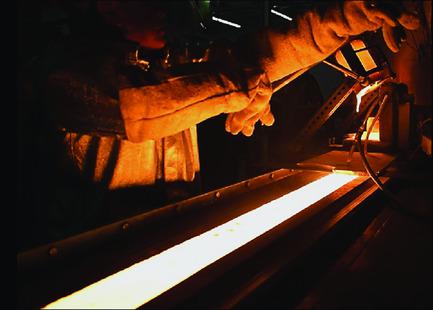当前位置:
X-MOL 学术
›
Steel Res. Int.
›
论文详情
Our official English website, www.x-mol.net, welcomes your
feedback! (Note: you will need to create a separate account there.)
Horizontal Single Belt Casting of Thin Strips of an Advanced High Strength Steel (Fe–21%Mn–2.5%Al–2.8%Si–0.08%C wt%)
Steel Research International ( IF 1.9 ) Pub Date : 2020-08-06 , DOI: 10.1002/srin.202000203 Usman Niaz 1 , Mihaiela Minea Isac 1 , Roderick I.L. Guthrie 1
Steel Research International ( IF 1.9 ) Pub Date : 2020-08-06 , DOI: 10.1002/srin.202000203 Usman Niaz 1 , Mihaiela Minea Isac 1 , Roderick I.L. Guthrie 1
Affiliation

|
This research presents numerical modeling and experimental results on thin strips of Fe–21%Mn–2.5%Al–2.8%Si–0.08%C wt% steel, obtained using the horizontal single belt casting (HSBC) process. The free stream of the molten metal, exiting from a nozzle slot, was observed to be highly unstable and nonuniform, after interacting with a 30° inclined refractory plane of a delivery system. However, increasing the inclination of the refractory plane to 45°–60° allows the falling molten metal free stream to become much more stable and less fluctuating. In addition, the molten metal can undergo a hydraulic jump when impacting and flowing down these inclined refractory planes. These hydraulic jumps result in the generation of free surface waves, which travel further downstream. Fortunately, these instabilities are not usually detrimental to the surface quality of the casting, as they are rapidly damped, to disappear within a short distance, prior to solidification. The types and numbers of solid phases then forming for this steel, under the relevant Scheil cooling conditions, are determined using FactSage software. The surface roughness of the cast strip was evaluated using a Nanovea 3D surface profilometer. Microstructures of the cast and heat‐treated strips were determined using Optical and Electron microscopes.
中文翻译:

先进高强度钢薄带的水平单带铸造(Fe–21%Mn–2.5%Al–2.8%Si–0.08%C wt%)
这项研究提供了采用水平单带铸造(HSBC)工艺获得的Fe–21%Mn–2.5%Al–2.8%Si–0.08%C wt%钢薄带钢的数值模型和实验结果。在与输送系统的30°倾斜耐火层相互作用后,观察到从喷嘴槽流出的熔融金属自由流非常不稳定且不均匀。但是,将耐火层的倾斜度增加到45°–60°可使下落的熔融金属自由流变得更加稳定且波动较小。另外,当熔融金属冲击并向下流向这些倾斜的耐火材料平面时,它们可能会发生水力跳跃。这些水力跃变导致产生自由表面波,该表面波向下游传播。幸好,这些不稳定性通常不会对铸件的表面质量产生不利影响,因为它们会被迅速阻尼,从而在凝固之前的短时间内消失。然后,在相关的Scheil冷却条件下,使用FactSage软件确定该钢形成的固相类型和数量。使用Nanovea 3D表面轮廓仪评估铸钢带的表面粗糙度。使用光学和电子显微镜确定铸造和热处理带材的显微组织。使用Nanovea 3D表面轮廓仪评估铸钢带的表面粗糙度。使用光学和电子显微镜确定铸造和热处理带材的显微组织。使用Nanovea 3D表面轮廓仪评估铸钢带的表面粗糙度。使用光学和电子显微镜确定铸造和热处理带材的显微组织。
更新日期:2020-08-06
中文翻译:

先进高强度钢薄带的水平单带铸造(Fe–21%Mn–2.5%Al–2.8%Si–0.08%C wt%)
这项研究提供了采用水平单带铸造(HSBC)工艺获得的Fe–21%Mn–2.5%Al–2.8%Si–0.08%C wt%钢薄带钢的数值模型和实验结果。在与输送系统的30°倾斜耐火层相互作用后,观察到从喷嘴槽流出的熔融金属自由流非常不稳定且不均匀。但是,将耐火层的倾斜度增加到45°–60°可使下落的熔融金属自由流变得更加稳定且波动较小。另外,当熔融金属冲击并向下流向这些倾斜的耐火材料平面时,它们可能会发生水力跳跃。这些水力跃变导致产生自由表面波,该表面波向下游传播。幸好,这些不稳定性通常不会对铸件的表面质量产生不利影响,因为它们会被迅速阻尼,从而在凝固之前的短时间内消失。然后,在相关的Scheil冷却条件下,使用FactSage软件确定该钢形成的固相类型和数量。使用Nanovea 3D表面轮廓仪评估铸钢带的表面粗糙度。使用光学和电子显微镜确定铸造和热处理带材的显微组织。使用Nanovea 3D表面轮廓仪评估铸钢带的表面粗糙度。使用光学和电子显微镜确定铸造和热处理带材的显微组织。使用Nanovea 3D表面轮廓仪评估铸钢带的表面粗糙度。使用光学和电子显微镜确定铸造和热处理带材的显微组织。











































 京公网安备 11010802027423号
京公网安备 11010802027423号